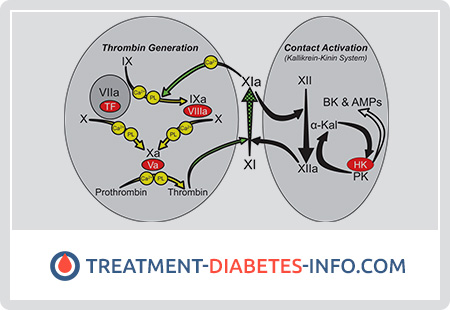What is Deficiency Factor XI?
The disease was first described in 1953 by Rosenthal scientists and co-authors. Since 1962, according to the International Nomenclature, this factor is denoted by the number XI.
Inheritance
The disease is inherited by the autosomal type of inheritance, and therefore, the PTA-failure of the people of both sexes is affected by PTA.
There are 2 genetically different variants of PTA deficiency.
Symptoms of Factor XI Deficiency
There are hidden, small and severe forms of the disease. With the first (more than 50% of all patients) bleeding occasionally occurs only with major injuries and operations. In patients with a mild form of the disease, spontaneous bleeding is minimal or absent, but there are regular bleeding after injuries and surgical interventions. Small surgical interventions, removal of teeth only occasionally accompanied by bleeding.
For the severe form of the disease, both moderate spontaneous bleeding (nasal bleeding, slight bruising) and prolonged and heavy bleeding during surgical interventions are characteristic. Subcutaneous and intermuscular hematomas and acute hemorrhages in the joints are rarely observed, and therefore the disease acquires some similarity with the mildest types of hemophilia A or B.
In women, heavy menstrual bleeding is not always noted and mostly only in the pubertal period. Extremely rarely, literally in isolated cases, postpartum hemorrhage is recorded. For most women, including those with very low levels of factor XI in plasma, no blood transfusions are required during labor.
In contrast, injuries and surgical interventions for PTA failure may be complicated by heavy and life-threatening bleeding. Often, such bleeding becomes a complete surprise to the attending physicians, since neither the questioning of patients nor the preoperative coagulogram allow one to suspect a malfunction in the hemostasis system. The unusual situation is aggravated by the fact that even with severe PTA failure, not all operations and injuries are accompanied by bleeding. Meanwhile, “bloodless” previous interventions should not dull the vigilance of surgeons, since with PTA failure, any operation is potentially dangerous.
Diagnosis of Factor XI Deficiency
Diagnosis of PTA failure is difficult and far from always reliable.
Laboratory diagnosis is also difficult, since the results of coagulation tests, such as clotting time, consumption of prothrombin, usually remain normal or are so weak and intermittent that they do not attract the attention of doctors.
For a more reliable recognition of latent clotting disorders, pre-operative examination of patients should include highly sensitive and easily performed modern coagulation tests.
The laboratory tests listed above allow to distinguish the deficiency of factor XI from hemophilia A and B, but not from the Hagemann defect (deficiency of factor XII). The latter is easily recognized by a significantly greater lengthening of the total clotting time and activated partial thromboplastin time than with PTA-deficiency, and this clotting disorder contrasts with the complete absence of any hemorrhagic phenomena in the patient and his relatives.
Nevertheless, a number of additional studies, mixing tests and quantifying factor XI are needed to more effectively exclude the deficiency of factor XI.
In recent years, immunological determination of factor XI has begun to be applied. It has been established that most forms of PTA-failure are based on insufficient synthesis of factor XI, and not on the formation of its functionally defective molecules.
Treatment of Factor XI Deficiency
Reliable relief and prevention of bleeding caused by PTA-failure is ensured by the transfusion of native fresh frozen or dried plasma.
Jet transfusions of such plasma at a dose of 4-5 ml / kg increase the level of factor XI in plasma by 10%, and at a dose of 9-10 ml / kg, respectively, by 20%.
The first dose is quite effective for ensuring hemostasis in small surgical interventions and in mild forms of PTA-insufficiency, and in case of severe forms of the disease and large surgeries it is better to use the second dose. The half-life of factor XI introduced into the bloodstream after the first transfusion is about 60 hours, and after repeated increases to 120 hours or more.
Of the non-specific methods of treatment for PTA-insufficiency, aminocaproic acid (at a dose of 0.2 g / kg) is most successfully used, which helps to prevent and relieve bleeding with minor injuries and operations (cuts, tooth extraction).
Nevertheless, a number of additional studies, mixing tests and quantifying factor XI are needed to more effectively exclude the deficiency of factor XI.
In recent years, immunological determination of factor XI has begun to be applied. It has been established that most forms of PTA-failure are based on insufficient synthesis of factor XI, and not on the formation of its functionally defective molecules.

